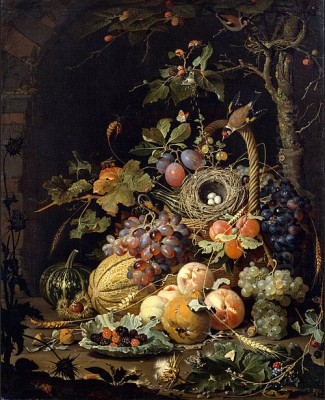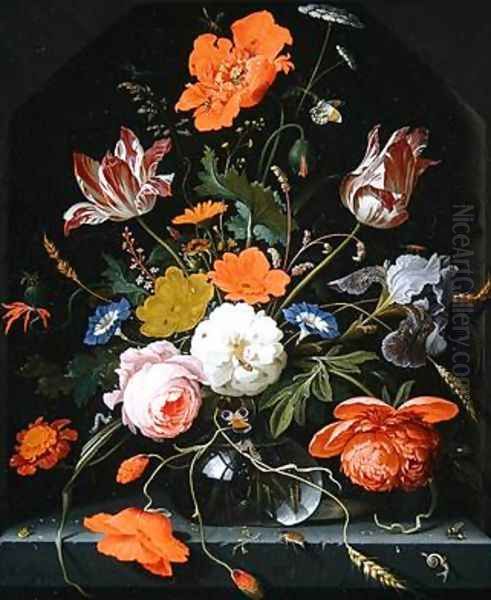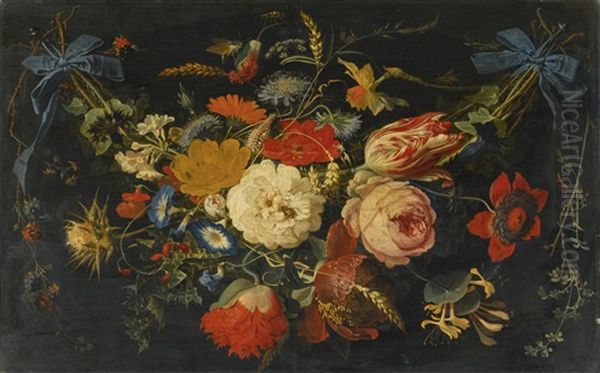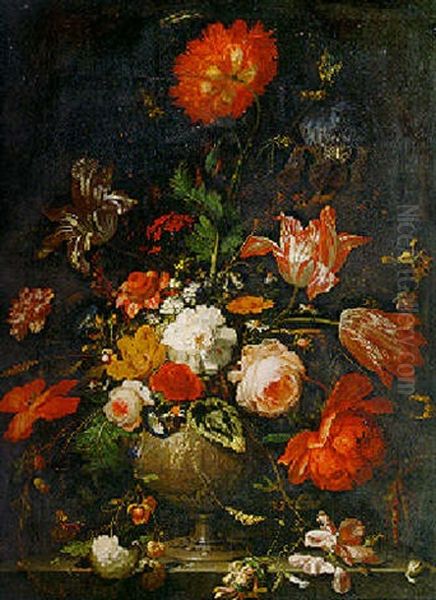
Abraham Mignon stands as a significant figure in the rich tapestry of Dutch Golden Age painting. Born in Frankfurt am Main in 1640, he became one of the most sought-after still life painters of his time, renowned for his incredibly detailed and vibrant depictions of flowers, fruits, and wildlife. Though his life was relatively short, ending in Utrecht in 1679, Mignon left behind a legacy of exquisite works that continue to captivate viewers with their technical brilliance and intricate beauty. His journey from Germany to the heart of the Dutch art world, his training under notable masters, and his unique artistic vision cemented his place in art history.
Early Life and Artistic Beginnings in Frankfurt
Abraham Mignon was baptized in Frankfurt am Main on June 21, 1640. His parents, Peter Mignon and Catharina le Bleu, were Calvinist refugees who had likely fled the Southern Netherlands due to religious persecution, settling in the more tolerant environment of Frankfurt. His father was a merchant. Recognizing young Abraham's artistic talent, his father placed him under the tutelage of the still life painter Jacob Marrel around 1649, when Mignon was just a young boy.
Jacob Marrel (c. 1613/14–1681) was himself a notable painter specializing in flower pieces. He had trained in Utrecht under Jan Davidszoon de Heem, a connection that would later prove pivotal for Mignon. Under Marrel's guidance, Mignon began to learn the fundamentals of still life painting, developing skills in observation and detailed rendering. Marrel was not only a painter but also an art dealer, providing Mignon with exposure to the broader art market and different styles.
Mignon remained with Marrel for several years in Frankfurt. During this period, Marrel also took on other pupils, including his stepdaughter, Maria Sibylla Merian (1647–1717), who would later become a famous naturalist and scientific illustrator. It is documented that Mignon was involved in teaching Merian, sharing the techniques he was mastering. This early experience highlights the collaborative and educational environment within Marrel's studio.
The Move to Utrecht and the Influence of Jan Davidsz. de Heem

Around 1664, Jacob Marrel decided to return to Utrecht, a major center for painting in the Dutch Republic. He brought the promising young Abraham Mignon with him. This move was crucial for Mignon's artistic development. Utrecht offered a vibrant artistic community and, most importantly, the opportunity to work directly with one of the era's greatest still life masters: Jan Davidszoon de Heem (1606–1684).
De Heem, whose studio Marrel himself had frequented earlier, was renowned for his opulent and complex still lifes, often featuring luxurious objects alongside natural elements. Mignon entered De Heem's workshop, likely initially as an assistant. Working alongside De Heem allowed Mignon to refine his technique significantly. He absorbed De Heem's sophisticated approach to composition, his mastery of light and texture, and his ability to create rich, harmonious color palettes.
The influence of De Heem is clearly visible in Mignon's mature works, particularly in the complexity of his arrangements and the luscious rendering of surfaces. However, Mignon developed his own distinct style, often characterized by slightly cooler tones, exceptionally fine detail, and a particular fondness for depicting flowers and fruits amidst darker, sometimes shadowy, settings, often incorporating insects and small animals. In 1669, Mignon's standing in the Utrecht art scene was formalized when he was accepted into the city's Guild of Saint Luke, the professional organization for painters and other artisans.
Artistic Style and Techniques
Abraham Mignon's art is defined by its meticulous realism and extraordinary attention to detail. He specialized primarily in still lifes, focusing on flower arrangements, fruit pieces, and forest floor scenes (known as 'sottobosco'). His technical skill allowed him to render the varied textures of petals, leaves, fruit skins, insect wings, and glass with astonishing accuracy, often inviting viewers to marvel at the verisimilitude.
His compositions are typically elaborate and dynamic, often featuring a diagonal thrust or an asymmetrical arrangement that adds energy to the scene. While influenced by De Heem's richness, Mignon's works sometimes possess a unique intensity, with objects densely packed yet clearly delineated. He frequently employed a dark, often indistinct background, using chiaroscuro (the contrast of light and shadow) to make the brightly lit flowers and fruits stand out dramatically. This technique enhances the three-dimensional quality of the objects and focuses the viewer's attention.

Mignon's color palette was rich and varied, though perhaps slightly cooler than De Heem's. He excelled at capturing the vibrant hues of flowers like tulips, roses, poppies, and carnations, as well as the subtle tones of ripening fruits such as grapes, peaches, and plums. His rendering of light was particularly masterful, capturing the way it reflects off smooth surfaces like glass or water droplets, and the way it defines the delicate structure of petals and leaves. Dewdrops, a common motif, showcased his virtuosity in depicting transparency and reflection.
A hallmark of Mignon's work is the inclusion of small creatures – butterflies, snails, beetles, caterpillars, ants, and sometimes mice, birds, or nests. These elements were not merely decorative; they added life and narrative potential to the scenes, often carrying symbolic weight related to themes of life, death, and transience, which were common in Dutch still life painting of the period.
Themes and Symbolism in Mignon's Work
Like many Dutch Golden Age still lifes, Mignon's paintings often operate on multiple levels, presenting beautiful arrangements that also convey deeper meanings. The most prevalent theme is likely vanitas, a reflection on the transience of life, the fleeting nature of beauty, and the inevitability of decay and death. This is subtly suggested through the inclusion of wilting flowers, overripe fruit, and insects that consume or destroy the natural elements. A watch, sometimes included as in Still life with flowers and watch, makes this theme explicit, symbolizing the passage of time.
Religious symbolism, often rooted in Christian iconography, is also present. Grapes and ears of wheat could symbolize the Eucharist (Holy Communion). Butterflies were often seen as symbols of the resurrection of Christ and the soul's immortality. Certain flowers carried specific meanings: roses could represent love or martyrdom, lilies purity, and poppies sleep or death. While Mignon was Calvinist, the use of such symbols was widespread and understood across different Christian denominations in the period.
His works featuring fruit, oysters, and fine glassware, such as Still-Life With Fruit, Oysters and A Porcelain Bowl, not only showcased his technical skill in rendering different textures and reflections but also pointed towards wealth and luxury. However, even these opulent displays could carry a vanitas message, reminding the viewer that earthly pleasures are temporary. The inclusion of partially peeled lemons, a common motif, could symbolize the deceptive nature of appearances – attractive on the outside but sour within – or simply serve as a display of artistic skill in rendering the complex texture.

Mignon also painted 'forest floor' still lifes, a subgenre popularized by artists like Otto Marseus van Schrieck. These works focused on the microcosm of life among plants, fungi, insects, and reptiles found in the undergrowth, emphasizing the wilder, untamed aspects of nature and often carrying complex allegorical meanings related to life, death, and the struggle for survival.
Representative Works
Abraham Mignon produced a considerable body of work during his relatively short career. Several paintings stand out as representative of his style and skill:
Flowers in a Glass Vase: This common subject for Mignon showcases his ability to render delicate blooms like tulips, roses, and irises with precision. The glass vase allows him to display his skill in depicting transparency and reflection, while the inevitable inclusion of insects adds life and symbolic depth. Many variations exist, held in collections worldwide.
Still life with flowers and watch: Housed in the Rijksmuseum, Amsterdam, this painting is a clear example of a vanitas still life. The lush bouquet, featuring peonies, tulips, and roses, is juxtaposed with a pocket watch, explicitly reminding the viewer of time's passage and the ephemeral nature of earthly beauty. Insects crawling on the flowers further emphasize decay.
Fruit Piece (various examples): Mignon excelled at depicting fruit, often combining grapes, peaches, plums, cherries, and citrus fruits in rich arrangements. He captured the varied textures, from the fuzzy skin of a peach to the translucent glow of grapes. Works like Grapes, Peaches, Blackberries, Acorns, Fine Glassware and Various Insects demonstrate his ability to create complex, tactile compositions.
Garland of Flowers: Mignon painted several works featuring garlands or swags of flowers, sometimes surrounding a central motif like a niche, a cartouche, or even a religious scene (e.g., Garland of Flowers with Madonna and Child). These works, influenced by artists like Daniel Seghers, allowed for elaborate displays of botanical variety and decorative composition. The work Garland of Flowers mentioned in the initial prompt likely refers to one such composition, highlighting his vibrant color use and detailed rendering of diverse flora.
Still Life with Fruit, Fish, and a Nest: This type of composition combines elements from different still life categories. The inclusion of fish might carry Christian symbolism (ichthys) or simply represent bounty. The bird's nest adds a touch of wild nature and themes of nurture and fragility. Mignon masterfully integrates these diverse elements into a cohesive whole.
These examples illustrate Mignon's consistent dedication to detailed realism, complex composition, rich color, and underlying symbolic content, solidifying his reputation as a master of the still life genre.
Mignon in the Context of the Dutch Golden Age
The Dutch Golden Age (roughly the 17th century) was a period of extraordinary artistic production in the Netherlands. Fueled by economic prosperity, burgeoning trade, and a dominant Protestant middle class eager to decorate their homes, the art market flourished. Unlike in Catholic countries where the church and aristocracy were the main patrons, Dutch art was largely bought by merchants, guilds, and affluent citizens. This led to a demand for genres that suited domestic settings, such as portraits, landscapes, genre scenes (depictions of everyday life), and still lifes.
Within this context, still life painting reached unprecedented levels of specialization and refinement. Artists focused on specific subgenres: flower painting ('bloemstukken'), fruit painting ('fruitstukken'), banquet pieces ('banketjes' or 'ontbijtjes'), luxurious still lifes ('pronkstilleven'), game pieces, and vanitas paintings. Abraham Mignon worked primarily within the categories of flower, fruit, and forest floor still lifes, often blending elements of the 'pronkstilleven' with his detailed naturalism.
Utrecht, where Mignon spent his most productive years, was a significant artistic hub. While known earlier for the Utrecht Caravaggisti like Gerard van Honthorst and Hendrick ter Brugghen who focused on dramatic religious and genre scenes, by Mignon's time, it was also a center for refined still life and landscape painting. Mignon's presence alongside his teacher De Heem contributed significantly to Utrecht's reputation in this field.
Contemporaries and Artistic Milieu
Abraham Mignon worked during a period populated by numerous highly skilled painters. Understanding his contemporaries helps place his work in context:
Jan Davidsz. de Heem (1606–1684): Mignon's teacher in Utrecht, arguably the most influential still life painter of the era, known for his opulent compositions.
Jacob Marrel (c. 1613/14–1681): Mignon's first teacher, specializing in flower pieces, who bridged the German and Dutch art scenes.
Willem Kalf (1619–1693): A master of the 'pronkstilleven' (ostentatious still life), known for his depictions of luxurious objects like Chinese porcelain, silverware, and exotic fruits, rendered with atmospheric lighting. Active mainly in Amsterdam.
Willem van Aelst (1627–1683): Another specialist in elegant still lifes, particularly flower pieces and hunting still lifes ('jachtstukken'), known for his refined technique and cool color palette. He worked in Delft, Amsterdam, and also travelled to France and Italy.
Otto Marseus van Schrieck (c. 1619–1678): A key figure in developing the 'sottobosco' or forest floor still life, often depicting fungi, reptiles, and insects in dark, mysterious settings.
Rachel Ruysch (1664–1750): A highly successful female painter specializing in flower still lifes. Although her career peaked slightly after Mignon's death, she represents the continuation and culmination of the tradition he worked within.
Maria Sibylla Merian (1647–1717): Mignon's pupil and Jacob Marrel's stepdaughter. She became a renowned naturalist and artist, famous for her detailed illustrations of insects and plants, particularly from Surinam.
Rembrandt van Rijn (1606–1669): The towering figure of the Dutch Golden Age, primarily known for portraits, historical scenes, and biblical subjects, active mainly in Amsterdam. Though in a different genre, his mastery of light and psychology set a high bar for all Dutch artists.
Johannes Vermeer (1632–1675): Master of intimate genre scenes, celebrated for his exquisite handling of light and color, active in Delft.
Frans Hals (c. 1582–1666): A leading portrait painter, known for his lively brushwork and capturing the sitter's personality, active in Haarlem.
Jacob van Ruisdael (c. 1628–1682): The preeminent landscape painter of the Dutch Golden Age, known for his dramatic and evocative scenes.
Jan Steen (c. 1626–1679): A master of lively, often humorous and moralizing genre scenes.
Pieter de Hooch (1629–1684): Known for his tranquil domestic interior scenes, demonstrating a sophisticated understanding of perspective and light.
Daniel Seghers (1590–1661): A Flemish Jesuit painter (active in Antwerp) who specialized in flower garlands often surrounding religious images, influencing Dutch artists including Mignon.
Ambrosius Bosschaert the Elder (1573–1621) & Balthasar van der Ast (1593/94–1657): Earlier pioneers of Dutch flower painting whose meticulous style laid the groundwork for later artists like Mignon. Van der Ast was notably De Heem's teacher.
This vibrant artistic environment fostered both competition and collaboration, pushing artists like Mignon to achieve remarkable levels of technical skill and artistic expression.
Personal Life and Final Years
Details about Abraham Mignon's personal life beyond his artistic training and career are relatively scarce. Sources confirm his birth in Frankfurt and his move to Utrecht. His dedication to his craft seems to have been paramount. In 1675, he married Maria Willaerts, the daughter of the painter Adam Willaerts, further integrating him into the Utrecht artistic community. However, their marriage was short-lived.
Mignon remained active as a painter in Utrecht. His works were highly sought after during his lifetime, not only by Dutch collectors but also internationally, finding their way into prestigious collections across Europe, including that of Louis XIV of France. His success indicates a high level of productivity and a strong market demand for his particular style of detailed and decorative still life.
Tragically, Abraham Mignon's successful career was cut short. He died in Utrecht at the relatively young age of 39 and was buried on March 27, 1679. The reasons for his early death are not clearly documented. Despite his short lifespan, he created a significant oeuvre that secured his reputation.
Legacy and Reception
Abraham Mignon's legacy lies in his contribution to the peak of Dutch still life painting. He masterfully combined the detailed observation of nature with sophisticated compositional skills and, often, subtle symbolic meaning. His work exemplifies the technical perfection and aesthetic refinement achieved by Dutch Golden Age artists in the still life genre.
While perhaps slightly overshadowed in popular recognition by his teacher De Heem or later flower painters like Rachel Ruysch, Mignon's paintings have always been highly valued by collectors and connoisseurs. His influence can be seen in the work of subsequent still life painters in Utrecht and beyond. His role in teaching Maria Sibylla Merian is also significant, contributing to the development of one of the most important female artists and naturalists of the era.
Today, Abraham Mignon's works are held in major museums around the world, including the Rijksmuseum in Amsterdam, the Mauritshuis in The Hague, the Louvre in Paris, the Hermitage Museum in St. Petersburg, the National Gallery in London, and many others. His paintings continue to be admired for their exquisite detail, vibrant colors, and the captivating way they capture the beauty and fragility of the natural world, offering a window into the artistic preoccupations and achievements of the Dutch Golden Age. He remains a key figure for understanding the depth and diversity of 17th-century European art.